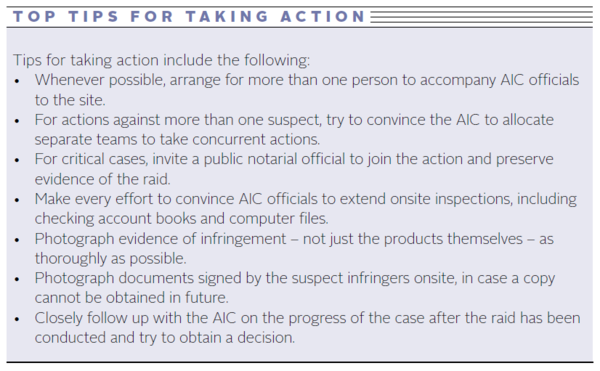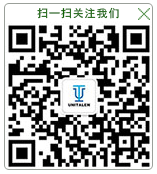How to Run an Administrative Raid in China
June 8, 2015The article is published in World Trademark Review Issue 54 - April 2015/May 2015 (Article Link)
Author: Dan Chen, Unitalen Attorneys at Law
While administrative raids are a popular anti-counterfeiting tool, ensuring that they work smoothly and efficiently is another matter. This could well hinge on the rights holder’s relationship with the local administration for industry and commerce.
Administrative raids are a popular anti-counterfeiting weapon for owners of Chinese registered trademarks. The Annual Development Report on China’s Trademark Strategy 2013 indicates that in 2013, administrations for industry and commerce (AICs) at all levels investigated and dealt with 49,971 trademark infringement and counterfeiting cases – including 11,735 foreign-related cases – with a total of 6.53 million illegal trademark labels being seized and destroyed, and 362 suspected criminal cases
and 347 suspects transferred to judicial organisations.
Considerations
Administrative raids are a swift enforcement measure which require a clear-cut case, obvious facts of infringement and no economic cooperation between the complainant and the complained-of party. As any AIC administrative decision is subject to administrative litigation if the punished party is dissatisfied with it, in practice AIC officials are more willing to initiate raids against counterfeits. If the level of similarity between the suspect infringing mark and the complainant’s mark is yet to be determined, it is better to choose a judicial approach over an administrative one. In addition, according to the Trademark Law, AICs may suspend the investigation and handling of a trademark infringement case if there is any dispute over ownership of the trademark in question or if the rights holder has instituted infringement proceedings before a court. Owners of trademark registrations undergoing cancellation or dispute proceedings thus need to be cautious when it comes to filing complaints with an AIC.
AICs will be unable to conduct a raid if a shop, warehouse or factory has a residential address. Rights holders and their attorneys should thus try to locate other non-residential addresses in order to carry out raids or seek cooperation from the local public security bureau.
Preparatory investigations
Preparatory investigations are a crucial step in collecting the basic facts of infringement for filing a complaint with an AIC. The information to be verified or collected includes the following:
? Identity, location and contact number of the suspect infringer – clues suggesting that infringement is taking place, especially those obtained online, are sometimes inaccurate, incomplete or outdated and so need to be verified with company registration information held at the local AIC. Even so, the infringer’s physical address may still be different from that recorded at the AIC, as some companies change their office address without recording this. Therefore, a phone call under a false pretext should be made to the target in order to confirm its current address.
? Photographs of the infringing products – in practice, photos (preferably colour photos) which directly reflect the infringement situation are useful when filing complaints with an AIC; those taken in the presence of a notarial officer will carry even more weight. Rights holders should make sure to communicate in advance with investigators in order to outline the details of what to look out for in order to distinguish counterfeits from genuine goods.
? Samples of infringing products – infringers are getting savvier and sometimes refuse visits by investigators posing as business people, making it difficult for them to take photographs of the site of the infringement. In addition, covertly taken photos are not always clear enough for rights holders to verify whether the goods in question are in fact counterfeit. Therefore, it is advisable to purchase a sample of the suspect infringing goods, preferably in the presence of a notarial officer. There are several other benefits to obtaining samples, such as lessening – if not fully eliminating – the alert given to the target and obtaining direct evidence of pricing.
"In 2013, AICs at all levels investigated and
dealt with 49,971 trademark infringement
and counterfeiting cases"
Information about the warehouse or factory – visitors to Silk Street Market in Beijing will have noticed the complete absence of physical counterfeit goods for sale; instead, there are only photos of the goods. Once the purchaser and the seller agree on a deal, the seller will ask someone to fetch the products from a hidden warehouse. As a result, administrative actions in such markets have little effect. Yet locating a counterfeit warehouse or factory is an extremely tough job for an investigator, requiring patience, courage, skill and determination. A preparatory investigation can actually involve several investigations for just one case. Even after all of the above information has been gathered, it is still advisable to conduct a final check immediately before filing a complaint with the local AIC. After an investigation is completed, several weeks may pass before the rights holder decides to proceed with an administrative raid. A further check on the physical address, the existence of infringing products and a clear idea of the route to the site and the target’s business habits will help to maximise the raid’s impact. Owners of infringed trademarks should keep in close contact with investigators during this process and give prompt instructions as early as possible in order to avoid later changes of situation, as well as the extra cost and time of a re-check.
Documents for filing complaints
The documentary requirements for filing a complaint with the AIC will vary depending on the nature of the complainant. While a copy of the trademark registration certificate and basic facts about the suspected infringer and the suspected infringing goods are the most essential documents, rights holders filing complaints by themselves must also provide a copy of their certificate of legal qualification. A trademark agency filing a complaint on behalf of a client shall provide a copy of its own business licence, with the scope of business expressly including the term ‘trademark agency’, as well as a power of attorney issued by its client. Notarisation and legalisation of the power of attorney will be necessary if the rights holder is a foreign entity or individual. If the complaint is filed by an exclusive licensee of the registered mark, a copy of the exclusive licence agreement must be provided.

Something that is easily overlooked, and which may cause a serious delay to the whole action, is the trademark registration certificate. This is particularly true for international trademarks that have been extended to China through the Madrid Agreement and/or Protocol. While most rights holders will already be aware that the registration certificate issued by the World Intellectual Property Organisation’s International Bureau is not valid proof of protection, they may be unaware that a notice of grant of protection issued by the Chinese Trademark Office after examination of an international trademark still cannot be accepted by an AIC as the proof of right for launching a raid. An additional application must be filed with the Trademark Office to obtain a certificate of registration for an international trademark. This process takes at least one month and sometimes up to four. Canny owners of international marks should take steps to obtain this document immediately after their marks are granted protection in China.
Another document that can be prepared in advance is a certificate of authentication. In the course of an administrative raid, AIC officials cannot immediately detain the goods unless they are verified as infringing by the rights holder or its agent onsite. To facilitate AIC action, a semi-prepared certificate of authentication sealed by the rights holder’s agency can be brought to the site and then filled in as necessary.
Planning complaints
Correct AIC level
Theoretically speaking – and in line with the territorial principle of AIC administration – a complaint can be filed with the authoritative AICs at various levels, from the grassroots industrial and commerce offices to district AICs, municipal AICs or even provincial AICs. In order to strike a balance between efficiency and professionalism, ideally a complaint can be filed with an AIC at the municipal level, which has more experience and less inclination towards local protectionism. Depending on its workload and internal division of duties, the municipal AIC may appoint a district AIC or its own economic inspection team to handle the case.
Proper timing
Timing directly affects the efficiency and effectiveness of an administrative action. In 2008, when the Olympic Games were held in China, AIC focus shifted to protecting the special symbols of the Olympic Games and complaints lodged by other rights holders did not receive prompt attention during that period. Similarly, AICs tried to cut back administrative raids when the Asia-Pacific Economic Cooperation Summit was held in Beijing in 2014 to avoid causing social unrest. On the other hand, AICs seem to be more active in undertaking administrative raids at the end of each year, presumably to try to improve their performance record. In addition, some goods have obvious peak seasons on the market. For example, a raid action against infringing wines would be much more fruitful conducted before a national holiday than after, in the same way that infringing stationery is more likely to appear on the market just before the start of the school year.
Building relationships with AICs
Some foreign trademark owners still labour under the misconception that AICs tend to protect local businesses. In reality, AICs have been fighting actively against counterfeit and infringing products for many years and the State Council has now set up a directing team for national anti-counterfeiting activities, headed by Deputy Prime Minister Wang Yang. As a unit member of the directing team, the State Administration for Industry and Commerce sets goals for local AICs and evaluates their achievements on a regular basis. Believe it or not, AIC officials are more than eager to discover counterfeit and infringing products, and often turn to local trademark agencies for help in verifying suspect goods found in markets. However, some rights holders do not want to be bothered when only small volumes of suspect goods are involved. What is missed here is the opportunity of knowing more AICs and developing cooperative relationships with them.
"Some foreign trademark owners still
labour under the misconception that AICs
tend to protect local businesses"
AICs are eager to demonstrate their commitment to the anti-counterfeiting infringement campaign. Rights holders and their agencies which have benefited from administrative actions should consider publicising the AIC’s achievements accordingly, which could also have the side effect of warning other counterfeiters or infringers. Another way to build closer relationships with AICs and to rid the market of counterfeit goods is to seek longterm cooperation with some AICs by organising regular market sweeps. In short, building a relationship with AICs is like building any friendship – if you demonstrate your faith and respect, you will receive support in return.




